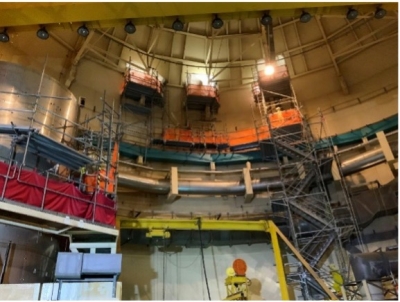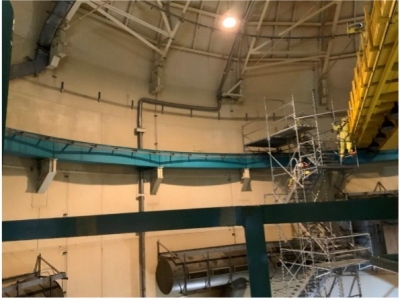Safe and On Time for Even the Most Dangerous Jobs

New scaffolding being assembled to reach 85’
to work on the clearances from the liner.
Regulations pertaining to a nuclear reactor are very strict for obvious safety reasons. When Nextera Energy, the principal subsidiary of Florida Power & Light, began their Point Beach Containment Dome Truss Modification project, it warranted some of the best union carpenters in the business. This job called for precision, safety and trained workers to pull it off.
This dome truss project underwent many years of engineering and planning due to its complexities. In fact, the structural analysis of the dome truss was first performed in 2011. Six of the 18 dome trusses were identified by the Nuclear Regulatory Commission as requiring modification to ensure the licensing of the reactor. The problem? Hanging from the three-foot thick concrete dome is a 4” pipe containing chemicals designed to stop the reaction process. Unfortunately, the system containing the chemicals was never engineered properly to hold them according to the safety regulations. As a result, the dome truss structure was too close to the steel liner inside of the concrete reactor containment building. Therefore, the truss structure did not meet the required safe structural clearance or distance from the trusses and containment liner. The current design left an approximate 3/8’ gap between it and the liner. If there was a seismic event, it could result in damage to the integrity of the containment building.

Photo of the dome, liner, and trusses.
To ensure licensing of the reactor, seven of the 18 dome trusses had to be cut and modified allowing more clearance between the liner and the truss. Three of these trusses needed to be worked on above the reactor cavity. As shown in the bottom photo, the cavity’s water level is at approximately 65’ above the reactor core. The scaffold working platforms needed to be 85’ above the highest water line and over 140’ above the Reactor Core.
To accomplish this task, two 70’ towers of scaffolding costing $70,000 each were purchased. A scaffolding mockup was completed ahead of time to ensure there were no delays and everything was handled safely. Used scaffolding could be utilized if it was available and cleaned prior to use. However, the amount needed was not available at the time. Once the two towers were purchased and the correct amount was on site, thousands of pieces of scaffold materials needed to pass from the hands of one person to the next without any mechanical means. Each and every piece was handed from one person to the next until the 85’ tower was completed. There was also another 20’ of platform used to reach the scaffolding.
Carpenters were required to work from extreme heights while adhering to all rail safety guidelines for building scaffold on the 22” Polar Crane rail within the containment. Making matters even more difficult was ensuring that no object, equipment or tool, was ever dropped adhering to all foreign material exclusion guidelines. While the orange barrier, called pearl weave, was used along the scaffolding, there are no allowances for dropping anything due to the strict guidelines enforced on this jobsite. Carpenters maintained superior three-way communication, held interactive job briefings and only put the most confident and experienced workers at the highest elevations.

Scaffolding being instructed near the dome
of the containment building.
After 11 years of research, engineering and analysis, 60 carpenters and 60 laborers were requested to complete the project. The project ended with 100 of each working 24 hours per day in 12-hour shifts. The project was required to be done in five days; it was completed one day early. A normal budget for a 25-day nuclear power outage for carpenters and laborers typically costs $1.3 - $1.5 million. The complexities, planning and difficulty of this job put the final cost millions of dollars more with all building trades involved.
“I was very pleased with the professionalism of all the men and women union carpenters involved with this amazing accomplishment,” said Paul Baranek, President of Local 1146 (Green Bay, WI) and BHI Energy Civil Supervisor at Point Beach. “Our brothers and sisters were able to successfully build and remove these scaffolds without any human performance issues while keeping the job on schedule. Nextera Energy and Florida Power & Light management were very impressed with the performance and dedication of our union trades.”